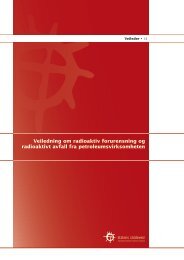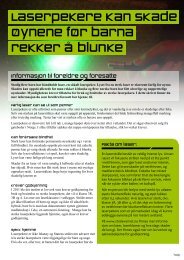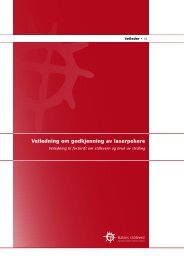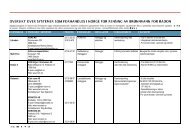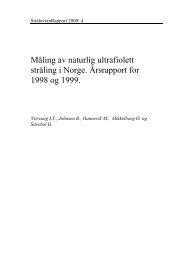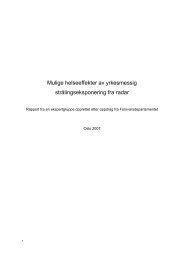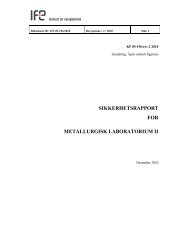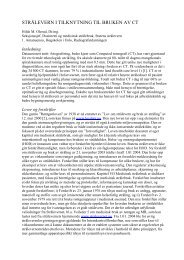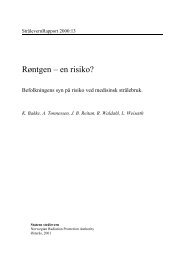Indoor Tanning in Norway - Statens strålevern
Indoor Tanning in Norway - Statens strålevern
Indoor Tanning in Norway - Statens strålevern
Create successful ePaper yourself
Turn your PDF publications into a flip-book with our unique Google optimized e-Paper software.
The IARC Work<strong>in</strong>g Group Report from 2006<br />
po<strong>in</strong>ts out that few countries regulate <strong>in</strong>door<br />
tann<strong>in</strong>g, and compliance studies show <strong>in</strong><br />
general poor agreement with regulations (1, 7).<br />
In Scotland there has been no national<br />
regulations regard<strong>in</strong>g use of tann<strong>in</strong>g devices.<br />
Two studies from Scotland <strong>in</strong> 1997 and 2004-<br />
2005 (14-16) showed <strong>in</strong>creased short wave and<br />
total UV irradiances, i.e. the opposite trend<br />
from what was found <strong>in</strong> <strong>Norway</strong>. There is no<br />
restriction with respect to UV type <strong>in</strong> Scotland.<br />
For comparison, the number of tann<strong>in</strong>g devices<br />
comply<strong>in</strong>g with UV type 3 requirements was<br />
17 % <strong>in</strong> Scotland <strong>in</strong> 2004-2005.<br />
The improvements seen <strong>in</strong> <strong>Norway</strong> for all<br />
requirements <strong>in</strong> the follow up <strong>in</strong>spections <strong>in</strong><br />
1999 and <strong>in</strong> the <strong>in</strong>spections <strong>in</strong> 2003 (Table A2,<br />
Fig. 4 and 5) demonstrates the importance of<br />
<strong>in</strong>spections. Much publicity after the first<br />
survey may have caused attention to the<br />
existence of regulations and motivated for<br />
better compliance <strong>in</strong> <strong>Norway</strong>.<br />
WHO, ICNIRP and EUROSKIN recommend<br />
that <strong>in</strong>door tann<strong>in</strong>g facilities have qualified<br />
personnel that can guide the customers<br />
regard<strong>in</strong>g length and <strong>in</strong>terval of their tann<strong>in</strong>g<br />
sessions (3-5). The results of our more<br />
technical compliance surveys do not favour<br />
any choice of attendance level (Table A2).<br />
Note that all Norwegian tann<strong>in</strong>g facilities may<br />
be considered unattended s<strong>in</strong>ce there has been<br />
no tra<strong>in</strong><strong>in</strong>g requirements for the staff until<br />
2004. Lack of qualified personnel will<br />
probably be the case <strong>in</strong> all countries without<br />
national tann<strong>in</strong>g regulations with tra<strong>in</strong><strong>in</strong>g<br />
requirements. In any case, the debate is<br />
essential also with respect to restrict<strong>in</strong>g<br />
admission to <strong>in</strong>door tann<strong>in</strong>g for those with low<br />
tann<strong>in</strong>g ability and for m<strong>in</strong>ors.<br />
5 Irradiance of <strong>in</strong>door<br />
tann<strong>in</strong>g compared to<br />
natural sun<br />
UV spectra for natural summer sun at noon<br />
were simulated for selected locations: the cities<br />
Tromsø (northern <strong>Norway</strong>) and Oslo<br />
(southeast <strong>Norway</strong>), Nice (southern France),<br />
Crete (Greece), Gran Canaria (Canary Islands)<br />
and Brisbane (Australia). A radiation transfer<br />
model, FastRT, was used for the conditions<br />
cloudless sky, sand environments, sea level,<br />
local noon and midsummer (43-45). Average<br />
ozone values for the years 2005 to 2007 at<br />
midsummer was used (Table A5). Simulated<br />
UV spectra for Oslo were <strong>in</strong> good agreement<br />
with measured spectra.<br />
UV <strong>in</strong>dex<br />
14<br />
12<br />
10<br />
8<br />
6<br />
4<br />
2<br />
0<br />
Maximum UV <strong>in</strong>dex for different locations - natural sun<br />
3.5<br />
Short-wave Long-wave<br />
5.4<br />
8.1<br />
9.8<br />
10.9<br />
Tromsø Oslo Nice Crete Gran<br />
Canaria<br />
12.9<br />
Brisbane<br />
Figure 7. Maximum UV <strong>in</strong>dex for different<br />
locations at midsummer with the contribution<br />
from short and long wave irradiance.<br />
UV irradiances and UV <strong>in</strong>dexes <strong>in</strong>crease with<br />
decreas<strong>in</strong>g latitude (Fig. 7 and Table A5). Due<br />
to larger <strong>in</strong>crease for UVB and short wave<br />
irradiances, the percentage UVB and short<br />
wave also <strong>in</strong>crease.<br />
The UV <strong>in</strong>dex at Gran Canaria is comparable<br />
to the average UV <strong>in</strong>dex of the <strong>in</strong>spected<br />
sunbeds <strong>in</strong> 2003 (Fig. 6 and 7). However, the<br />
contribution from long wave irradiance is<br />
much higher for the sunbeds.<br />
The spectra for natural sun are further<br />
compared to those from three tann<strong>in</strong>g devices<br />
with lamps frequently observed dur<strong>in</strong>g the<br />
<strong>in</strong>spections (Table A5 and Fig. A1). These<br />
fluorescent lamps had high either short or long<br />
wave irradiance. For comparison, an old<br />
mercury arc sunlamp is <strong>in</strong>cluded. The<br />
spectrum for this lamp was measured with a<br />
Bentham DTM 300 spectroradiometer (see<br />
Appendix B for measurement procedure). The<br />
ratio of short and long wave irradiances of<br />
these devices compared to that of summer sun<br />
<strong>in</strong> Oslo is:<br />
17



